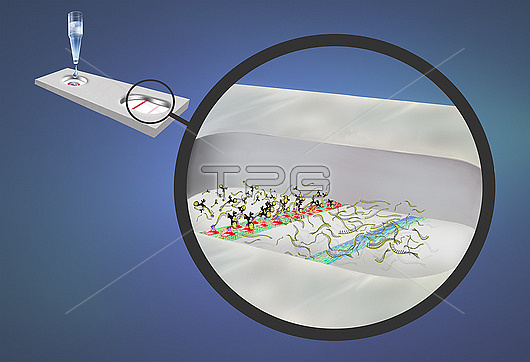
Illustration showing a sample being added to a flow detector using the SHERLOCK (specific high-sensitivity enzymatic reporter un-locking) diagnostic system. SHERLOCK uses an engineered CRISPR Cas 13 protein to detect nucleic acids. This allows it to detect any genetic signature including cancer. Here, SHERLOCK has been used to detect a possible viral infection. First, a sample is taken from the patient and ribonucleic acid (RNA) contained within the sample is amplified. Reporters, sensitive to the Cas 13 protein, are added to the RNA. This Cas 13 protein is programmed with guide RNA designed to only target the virus RNA. When the guide RNA and the virus RNA bind, this activates Cas 13's cleaving mechanism. The ends of the reporters carry different labels. Cas 13 separates these signatures creating a unique signal within the sample. The sample is applied to the flow detector. If negative for the virus, the reporter remains intact and is detected at the first detection line (centre, orange), as seen here. However, if the sample was positive for the virus, it collects at the second detection line (blue).
| px | px | dpi | = | cm | x | cm | = | MB |
Details
Creative#:
TOP27900741
Source:
達志影像
Authorization Type:
RM
Release Information:
須由TPG 完整授權
Model Release:
N/A
Property Release:
N/A
Right to Privacy:
No
Same folder images:

 Loading
Loading